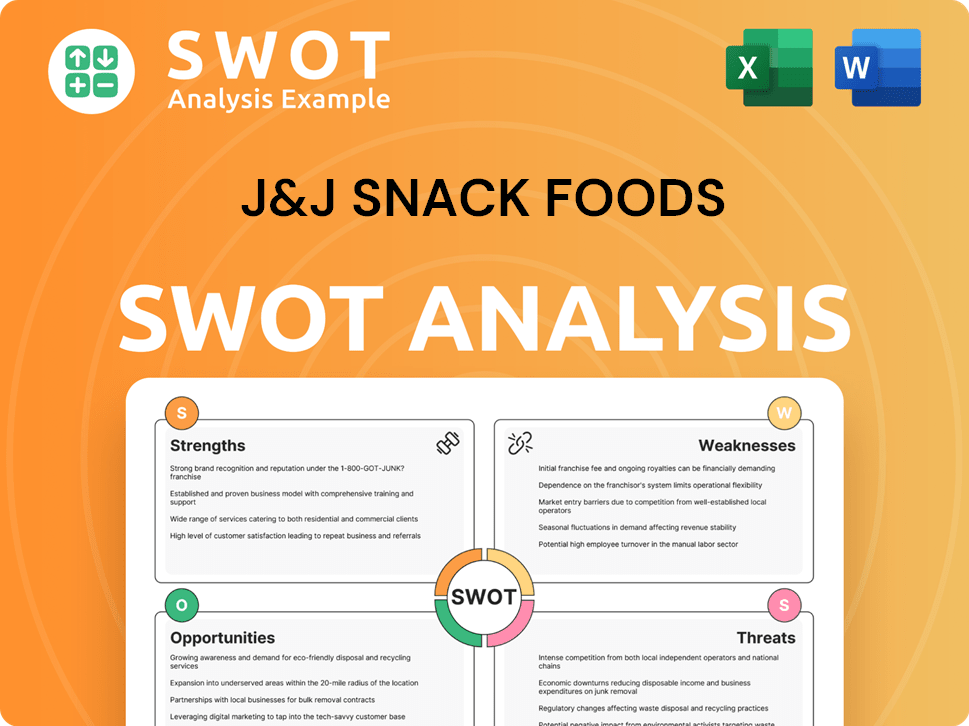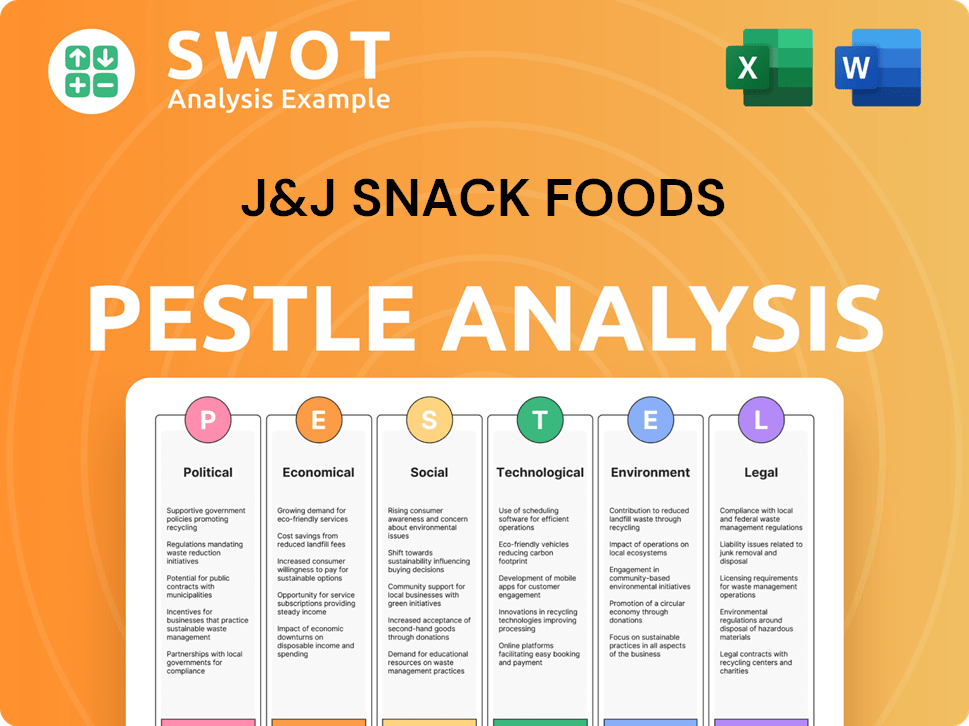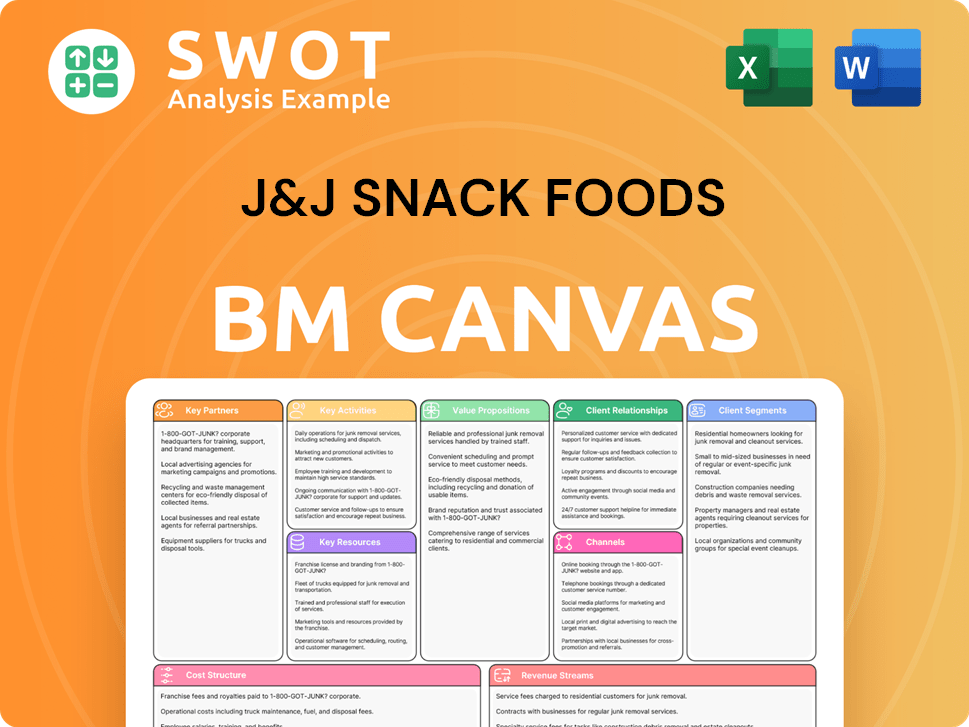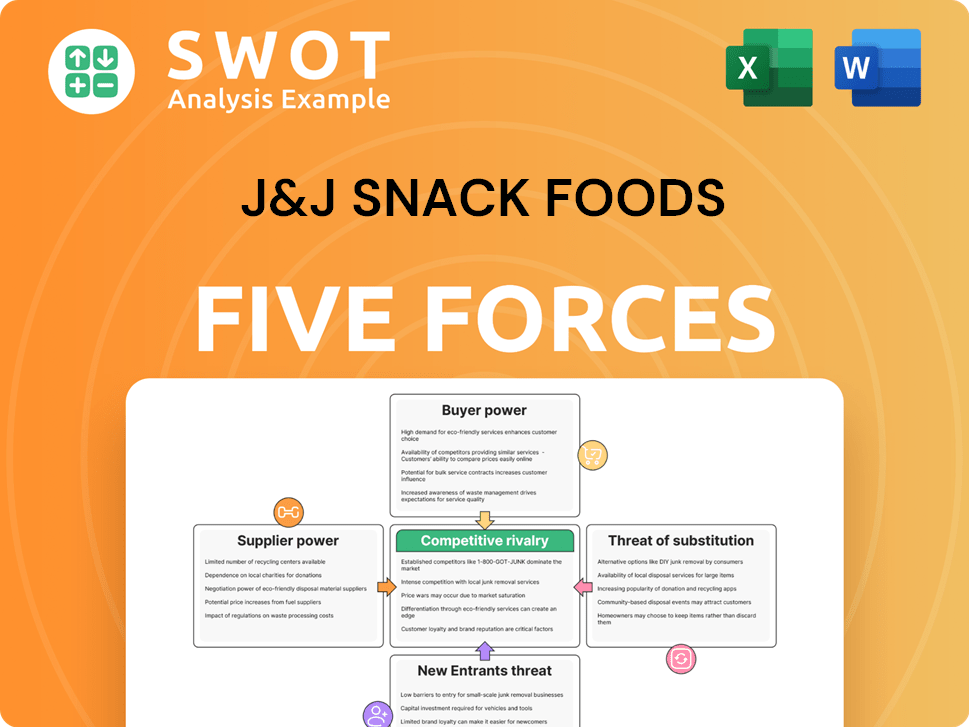J&J Snack Foods Bundle
Can J&J Snack Foods Company Continue Its Delicious Ascent?
From humble beginnings as a pretzel producer, J&J Snack Foods Company (JJSF) has transformed into a "fun foods" powerhouse, a testament to its strategic growth. Its acquisition of ICEE in 1987 marked a pivotal shift, expanding its frozen beverage portfolio and shaping its future. Today, with brands like SUPERPRETZEL and LUIGI'S, JJSF's market presence is undeniable, but what's next for this snack food titan?

The J&J Snack Foods SWOT Analysis reveals the strategies driving J&J Snack Foods Company's success in the dynamic snack food industry. Understanding the company’s growth strategy is critical, given evolving market trends and consumer preferences for convenience and healthier options. This analysis will explore J&J Snack Foods Company's future prospects, including expansion plans, innovation, and financial performance, providing a comprehensive business analysis of this market leader.
How Is J&J Snack Foods Expanding Its Reach?
The J&J Snack Foods Company is actively pursuing a multi-faceted expansion strategy. This approach focuses on both market penetration and product diversification to drive growth. The company aims to strengthen its position in the competitive snack food industry and capitalize on evolving market trends.
One key area of focus is expanding within existing foodservice channels. This includes places like schools, stadiums, and entertainment venues. By introducing new product variations and increasing its distribution reach, the company hopes to capture a larger share of these markets. Simultaneously, J&J Snack Foods Company is working to grow its retail presence in supermarkets, using its established brand recognition to gain more shelf space and attract consumers.
The expansion strategy also involves exploring new geographical territories within the U.S. where market penetration may be lower. Furthermore, the company is considering opportunities for international expansion, particularly for its well-known brands. This comprehensive strategy is designed to ensure J&J Snack Foods Company remains a leader in the snack and frozen treat categories.
The company is focusing on increasing its presence in foodservice channels. This includes schools, stadiums, and entertainment venues. They are introducing new product variations to increase sales and distribution.
Efforts are being made to grow retail presence in supermarkets. They are leveraging brand recognition to capture more shelf space. This strategy aims to increase consumer attention and drive sales.
The company is exploring new territories within the U.S. for expansion. This includes areas where market penetration is currently lower. The goal is to broaden its reach across the country.
There are plans to explore international expansion, especially for key brands. This includes looking at markets where their products can be successfully introduced. The focus is on global growth.
Product innovation is a critical part of J&J Snack Foods Company's expansion plans. They are consistently introducing new flavors and healthier options. Convenient packaging formats are also being developed to meet consumer demands.
- New flavors and healthier options are being developed.
- Efforts are focused on expanding 'better-for-you' snack options.
- Convenient packaging formats are being introduced.
- The goal is to cater to evolving consumer preferences.
J&J Snack Foods SWOT Analysis
- Complete SWOT Breakdown
- Fully Customizable
- Editable in Excel & Word
- Professional Formatting
- Investor-Ready Format

How Does J&J Snack Foods Invest in Innovation?
Innovation and technology are central to the growth strategy of J&J Snack Foods Company, enabling it to maintain its competitive position within the dynamic snack food industry. The company's approach involves continuous investment in research and development (R&D) to create new products and refine existing ones. This focus aligns with evolving consumer preferences, particularly the demand for healthier options, unique flavors, and convenient snacking solutions.
Digital transformation plays a significant role in optimizing J&J Snack Foods' operational efficiency and expanding its market reach. The company is likely investing in advanced manufacturing technologies, including automation, to enhance production processes, reduce costs, and improve product quality and consistency. While specific details on the use of cutting-edge technologies like AI or IoT are not extensively publicized, such technologies could be applied to supply chain optimization, demand forecasting, and personalized marketing efforts.
Sustainability initiatives are also increasingly integrated into J&J Snack Foods' strategy. This includes a focus on environmentally friendly packaging, responsible sourcing, and waste reduction, aligning with growing consumer and regulatory expectations. These efforts contribute to the company's growth objectives by expanding market share, improving profit margins, and enhancing brand loyalty. The company's consistent introduction of new and improved products under its well-known brands demonstrates its commitment to innovation.
J&J Snack Foods invests in R&D to create new products and improve existing ones. This includes both internal development and potential collaborations with external innovators. The company focuses on consumer trends such as healthier options and unique flavor profiles.
Digital transformation is key for operational efficiency and market reach. This includes investments in advanced manufacturing technologies, like automation. Potential use of AI and IoT for supply chain optimization and marketing.
J&J Snack Foods integrates sustainability into its strategy. This involves environmentally friendly packaging, responsible sourcing, and waste reduction. These initiatives align with consumer and regulatory expectations.
The company consistently introduces new and improved products. This demonstrates a commitment to innovation. The focus is on expanding market share and enhancing brand loyalty.
The company focuses on consumer trends. These include healthier options, unique flavors, and convenient consumption. The company adapts to changing consumer preferences.
Digital transformation improves operational efficiency. This includes optimizing production processes and reducing costs. The goal is to enhance product quality and consistency.
These new products, platforms, and technical capabilities directly contribute to growth objectives by expanding market share, improving profit margins, and enhancing brand loyalty. The company's consistent introduction of new and improved products under its well-known brands demonstrates its commitment to innovation.
- Market Share Expansion: Innovation helps to capture a larger portion of the snack food industry.
- Profit Margin Improvement: Efficient processes and new product offerings boost profitability.
- Enhanced Brand Loyalty: New and improved products strengthen customer relationships.
- Competitive Edge: Staying ahead through innovation is key in the Target Market of J&J Snack Foods.
J&J Snack Foods PESTLE Analysis
- Covers All 6 PESTLE Categories
- No Research Needed – Save Hours of Work
- Built by Experts, Trusted by Consultants
- Instant Download, Ready to Use
- 100% Editable, Fully Customizable

What Is J&J Snack Foods’s Growth Forecast?
The financial outlook for J&J Snack Foods Corp. appears stable, supported by consistent revenue generation and strategic investments. The company's performance in the snack food industry reflects a commitment to sustainable growth. This is evident in its ability to navigate market trends and maintain a strong financial position.
In the first quarter of fiscal year 2024, the company demonstrated positive financial results. This included an increase in net sales and earnings, indicating effective operational strategies. The company's focus on operational efficiencies, strategic pricing, and product innovation suggests a proactive approach to maintaining financial health and driving future prospects.
The company's financial strategy is designed to deliver shareholder value through organic growth and strategic capital allocation. This approach is supported by a strong balance sheet, which enables the company to pursue its growth ambitions. For more insights into the company's structure, consider reading about Owners & Shareholders of J&J Snack Foods.
J&J Snack Foods reported net sales of $370.0 million in Q1 2024, a 5.6% increase year-over-year. This growth showcases the company's ability to expand its revenue streams within the snack food industry.
The Food Service segment saw a 7.7% increase in sales during Q1 2024, highlighting its strong market position. This segment's performance is a key driver of the company's overall growth strategy.
Net earnings for Q1 2024 were $24.7 million, or $1.29 per diluted share, an increase from $22.7 million, or $1.18 per diluted share, in the prior year. This demonstrates improved profitability.
The gross profit margin improved to 26.5% in Q1 2024, up from 25.4% in the prior year. This increase reflects favorable pricing and product mix strategies.
The company focuses on operational efficiencies, strategic pricing, and product innovation. These initiatives support the company's growth strategy and future prospects within the snack food market.
- Operational efficiencies to reduce costs.
- Strategic pricing to maintain profitability.
- Product innovation to meet consumer demands.
- Strategic acquisitions to expand market share.
J&J Snack Foods Business Model Canvas
- Complete 9-Block Business Model Canvas
- Effortlessly Communicate Your Business Strategy
- Investor-Ready BMC Format
- 100% Editable and Customizable
- Clear and Structured Layout

What Risks Could Slow J&J Snack Foods’s Growth?
The J&J Snack Foods Company faces several potential risks and obstacles that could impact its growth strategy and future prospects within the competitive snack food industry. These challenges range from market dynamics to operational hurdles, requiring the company to maintain a proactive and adaptable approach. A thorough business analysis reveals the need for careful navigation of these potential pitfalls.
Intense competition in the snack and frozen beverage markets poses a significant threat. This competition can lead to price wars and requires substantial marketing investments. Regulatory changes, such as evolving nutritional guidelines, also present ongoing compliance risks, potentially increasing operational costs. Furthermore, the company must manage supply chain vulnerabilities and internal resource constraints effectively.
The company's ability to adapt to changing conditions and mitigate risks through continuous operational improvements and strategic adjustments is key. Understanding the potential obstacles is crucial for investors and stakeholders evaluating the J&J Snack Foods Company. The company's resilience in a competitive market suggests an ability to overcome these challenges.
The snack food industry is highly competitive, with numerous players vying for market share. This competition can lead to pricing pressures, impacting profitability. The company must continually innovate and differentiate its products to stay ahead.
Changes in food safety regulations, labeling requirements, and nutritional guidelines can increase compliance costs. Stricter ingredient regulations or evolving dietary recommendations could necessitate costly reformulations. The company must stay informed and adapt to these changes.
Fluctuations in raw material costs, like sugar and flour, can impact production costs. Disruptions in transportation or logistics can affect distribution. The company's profitability is susceptible to commodity price volatility, requiring robust supply chain management.
Competitors leveraging advanced technologies in manufacturing, distribution, or marketing could erode market share. Adapting to technological advancements is crucial for maintaining a competitive edge. Continuous innovation in processes and marketing is essential.
Labor shortages or difficulties in attracting and retaining skilled personnel can hinder expansion plans. Efficient management of human resources is critical for operational efficiency. The company needs to foster a positive work environment to retain talent.
Inflation and economic downturns can impact consumer spending on discretionary items. Changes in consumer behavior and preferences can affect demand for snack foods. The company must adapt its strategies to address these economic challenges.
The company employs a diversified product portfolio and customer base to mitigate risks. Robust risk management frameworks are in place for proactive identification and management. Scenario planning helps anticipate and prepare for potential disruptions. For more context, consider reading the Brief History of J&J Snack Foods.
J&J Snack Foods Company must continuously monitor market trends and adapt to changing consumer preferences. Health and wellness trends, including demand for healthier snack options, are significant. Sustainability efforts and eco-friendly packaging are also increasingly important to consumers.
J&J Snack Foods Porter's Five Forces Analysis
- Covers All 5 Competitive Forces in Detail
- Structured for Consultants, Students, and Founders
- 100% Editable in Microsoft Word & Excel
- Instant Digital Download – Use Immediately
- Compatible with Mac & PC – Fully Unlocked

Related Blogs
- What are Mission Vision & Core Values of J&J Snack Foods Company?
- What is Competitive Landscape of J&J Snack Foods Company?
- How Does J&J Snack Foods Company Work?
- What is Sales and Marketing Strategy of J&J Snack Foods Company?
- What is Brief History of J&J Snack Foods Company?
- Who Owns J&J Snack Foods Company?
- What is Customer Demographics and Target Market of J&J Snack Foods Company?
Disclaimer
All information, articles, and product details provided on this website are for general informational and educational purposes only. We do not claim any ownership over, nor do we intend to infringe upon, any trademarks, copyrights, logos, brand names, or other intellectual property mentioned or depicted on this site. Such intellectual property remains the property of its respective owners, and any references here are made solely for identification or informational purposes, without implying any affiliation, endorsement, or partnership.
We make no representations or warranties, express or implied, regarding the accuracy, completeness, or suitability of any content or products presented. Nothing on this website should be construed as legal, tax, investment, financial, medical, or other professional advice. In addition, no part of this site—including articles or product references—constitutes a solicitation, recommendation, endorsement, advertisement, or offer to buy or sell any securities, franchises, or other financial instruments, particularly in jurisdictions where such activity would be unlawful.
All content is of a general nature and may not address the specific circumstances of any individual or entity. It is not a substitute for professional advice or services. Any actions you take based on the information provided here are strictly at your own risk. You accept full responsibility for any decisions or outcomes arising from your use of this website and agree to release us from any liability in connection with your use of, or reliance upon, the content or products found herein.